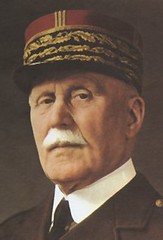Early in his memoir If This Be Treason: Translation and Its Dyscontents, Gregory Rabassa presents his reader with the conundrum of translation:
Within his cultural limits the author, as an individual, can and, indeed, must extend himself as far as he can to set himself and his art apart from the commonplace, showing all the while whence he comes, doing this through language most of all. With the translator we have quite the opposite situation. He cannot and must not set himself apart from the culture laid out before him. To do so would indeed be treasonous.
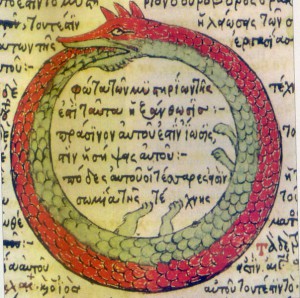 A translator, Rabassa goes on to explain, is not simply a writer but also a reader. If a translation is to be a successful one, the translator must be a particularly astute reader, attentive not only to the essentials but also to the cultural context whence the writer comes. And so we see how translation can become a snake biting its own tail: the translator as writer and reader is simultaneously subsumed and resurrected by the text in the original as a translation task. So the question becomes: how does the translator mount a sensitive, careful reading of a literary work as she writes it from one language into another?
A translator, Rabassa goes on to explain, is not simply a writer but also a reader. If a translation is to be a successful one, the translator must be a particularly astute reader, attentive not only to the essentials but also to the cultural context whence the writer comes. And so we see how translation can become a snake biting its own tail: the translator as writer and reader is simultaneously subsumed and resurrected by the text in the original as a translation task. So the question becomes: how does the translator mount a sensitive, careful reading of a literary work as she writes it from one language into another?
I knew to pose this question to myself only some years after I began, with what I might call dedicated chutzpah and utter naïveté, my translation of the semiautobiographical prose-poem novel I Saw You on the Street (Je vous ai vue dans la rue) by French writer Yolaine Simha. My efforts were buoyed by an undergraduate research grant I’d received to start the translation work, and motivated by my desire to translate as elegy. I had corresponded with Simha during a semester-long study abroad in Paris. We never met in person—her debilitating agoraphobia, which served as thematic fodder for I Saw You on the Street, saw to that—and in August 1999, six weeks after I had returned to the States, Simha committed suicide.
Simha left several notes before she took an overdose of barbiturates and jumped into the river behind her house in a farm town two hours outside of Paris. Several of the notes she left for friends include the statement “ce n’est pas une question d’angoisse mais de lassitude” (“it’s not a question of anguish but of exhaustion”). Along with Simha’s other works of fiction and experimental prose, I Saw You on the Street has languished, having received limited distribution before it was declared out of print. So it was an understandable impulse to want to translate her work as homage. But of course, this led to problems in reading in my initial work on the project, and by extension—if, as I do, you buy into Rabassa’s idea that translation is always an act of careful close reading—its translation.
I Saw You on the Street struck me for several reasons when I first read it, but what I found most compelling was the theme of women’s innovative negotiation of the Paris streets. Since I had come of age in a time when awareness about sexual harassment was all over the US media, I had found my transition to Paris trying, to say the least. In the late 1990s, being followed on the street in Paris was still viewed as a compliment rather than a menace. This was shocking to me, particularly since one of my central inspirations for becoming conversant in French had been the work of feminist thinkers such as Hélène Cixous and Luce Irigaray. I Saw You on the Street spoke directly to what had been rendered so beautifully abstract in the works of other French feminists I had read. Simha’s fictionalized testimony of what it was to traverse city streets and feel threatened while doing so resonated with me, and surely informed my early experiences of Paris.
Simha’s work, I should note, was a large part of what led to my decision to pursue a PhD in French a few years later. That is mostly a story for another time, but a few more details encapsulate my curiosity about the intersections between Simha’s life and work: she was half-Jewish, and was born into hiding in Paris during World War II. This was, by all accounts, the root of her agoraphobia. She had, nonetheless, identified not as a Jew, not as a French woman, but as a Levantine. She had adopted Esmeralda, a Turkish name, as part of her pen name. What exactly was the meaning behind her assumption of this vague and distant socio-cultural identity? In I Saw You on the Street, it seemed to play out through themes and images that reflected upon French historical memory of World War II and Vichy, as well as the contemporary immigrant situation in and around Paris.
So the deeper I got into what became a ten-year, on-again, off-again project to translate I Saw You on the Street—and especially once I began contextualizing it more through other literary and social texts and less through Simha’s biography—the more I saw how brazen I had been in approaching the translation of this work as a new speaker of French, and as a fledgling navigator of French culture and society.
I can point to three different periods of work on this translation project that might be helpful in considering the question of what it means to be a good reader if one is to be a good translator. My first attempt to translate I Saw You on the Street was spread out over two years, from November 2000 through the spring of 2002. The translation at this point served me more than Simha’s work: as I translated, I was also keeping up and developing my French. For all of my bull-in-a-chinashop approach to translation at this point, I will say that I was acutely aware of my shortcomings and lack of training any time I came across an unknown idiom, a particularly literary turn of phrase, some image or metaphor that seemed to be a literary or cultural reference.
I had two very kind readers of these first translation efforts, both tenured, full professors of French who had known Simha and taught her work to undergraduates. They were extraordinarily supportive readers: looking back at that first translation now, I can imagine that they both cringed and sighed multiple times as they made their gentle observations and raised helpful questions. With their prescience of advanced scholars, they were both aware, I would guess, that this version of the translation would open new avenues and possibilities for me, rather than lead to publication of the work in translation: I was working as an editor and playing in a band in Chicago, and this work allowed me to keep up my French during this time between undergraduate and graduate school. Their comments focused, for the most part, upon moments of poor reading, such as through cultural misunderstanding. They also helped me think about how to calibrate the translation of more literary verb tenses in this extremely terse and contemporary-sounding work. Above all, though, they both encouraged me, and for that, I can only thank these gentle and supportive readers.
My next translation was a far more rigorous and careful reading of the original work. This was in the summer of 2006, two years into coursework for my doctorate in French. My immersion experiences in French by this point included a summer in Aubervilliers in 2005, shortly before the riots broke out in that and other Paris suburbs. I had done some critical writing on I Saw You on the Street, as well, and as a literary critic and performance studies scholar who often attempts to embody the tone and style of the work I critique, I had had some time and practice with considering how to translate the tone of Simha’s work into English. These kinds of experiences suggest modes of reading that can lead to more careful translation of a contemporary work in a living language: through my new understanding of immigrant culture in France, I was reading Simha less obliquely from the embodied experience perspective. Through the body of knowledge I was amassing about literary traditions in French (and particularly in France), Simha’s work had become far more culturally intelligible to me. And my readers—including
the board of a well-known translation imprint who only decided not to publish the work because they felt it couldn’t be marketed within a specific genre—were far more forthright and incisive. Their criticism of my translation was direct and targeted at the sentence level: why did you translate this idiom in that way?, for instance. Based on their comments, I decided to allow some more time to pass, to return to translate I Saw You on the Street once more before submitting it to the publisher my readers from the first imprint had recommended. I had come much closer to being the kind of reader I wanted to be the second time. But more time, experience, and distance between myself and that second reading needed to pass before I was ready to call the third time the charm.
Third reading: summer and fall 2009. I didn’t realize until some weeks after the fact that I had resumed my work ten years to the week of Simha’s death, which I honored by continuing to read I Saw You on the Street as a work situated within and yet separate from her biography. And how things had changed for me as a translating reader! I was on fellowship, in the midst of writing my dissertation. Simha’s work became a gentle entree back into reading and writing, each and every morning. Since the work is divided into 128 prose-poems, each morning I would translate one to three pages. I would begin with a fresh translation—another few years of both reading through literary works in French and another summer plus a full year of research in Paris led me to feel both more confident of and more hesitant about my readerly authority. After completing the newest translation of one prose poem, I compared the newest version to the 2006 version. Then, I would make judgment calls about different turns of phrase, and I looked up oblique expressions and concepts online. If I failed to draw a satisfactory conclusion from Internet research, I would turn to friends who were native speakers to find out what
they thought of this or that in the work (and often it was the case in I Saw You on the Street, as was my hunch, that images such as “two kangaroos whose pockets overflowed with Scottish mice with black silky mustaches” were surrealist concoctions of Simha’s own design). I had become accustomed by my second pass through the work to relying on not only a French-English dictionary, but also a French dictionary, an English dictionary, and both French- and English-language thesauri. I combed my fingers through the hair of Simha’s work this time, I would say to friends. I wanted to render the work as seamlessly in English as it was in the French. If I learned anything from my third translation of I Saw You on the Street, it’s that good reading as a translator maintains a certain halting flow: I found that I needed to know when to stop, when to search, when to ask someone who might know better than me. Call this halting flow translator’s humility.
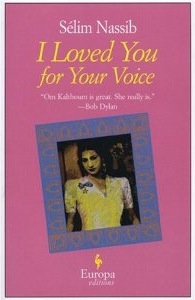 The translation of the elegant and epic crosscultural novel I Loved You for Your Voice (Europa Editions 2006, published in French by Balland in 1994 under the title Oum, written by Sélim Nassib) offers a particularly successful example of reading as writing. As is the case of I Saw You on the Street, in I Loved You for Your Voice, the translator’s conundrum is multiplied. I Loved You for Your Voice is a fictionalized account of the life and career of Om Kalthoum, the revered singer known as kawkab el-sharq (the Star of the East). The first-person narrator, Ahmed Rami, is the celebrated poet who wrote the lyrics to more than half of Kalthoum’s songs. Nassib’s novel could be, in a sense, qualified as a work in translation by default: with much of the dialogue between Rami, Kalthoum, and the other characters, it can be presumed that they are “speaking” in Arabic, although the dialogue is almost entirely written and read in French in the original, and in English in the 2006 Europa Edition.
The translation of the elegant and epic crosscultural novel I Loved You for Your Voice (Europa Editions 2006, published in French by Balland in 1994 under the title Oum, written by Sélim Nassib) offers a particularly successful example of reading as writing. As is the case of I Saw You on the Street, in I Loved You for Your Voice, the translator’s conundrum is multiplied. I Loved You for Your Voice is a fictionalized account of the life and career of Om Kalthoum, the revered singer known as kawkab el-sharq (the Star of the East). The first-person narrator, Ahmed Rami, is the celebrated poet who wrote the lyrics to more than half of Kalthoum’s songs. Nassib’s novel could be, in a sense, qualified as a work in translation by default: with much of the dialogue between Rami, Kalthoum, and the other characters, it can be presumed that they are “speaking” in Arabic, although the dialogue is almost entirely written and read in French in the original, and in English in the 2006 Europa Edition.
Translator Alison Anderson ably preserves the resonance and flutter of several crosscultural voices in her reading-writing of the French Oum into the English I Loved You for Your Voice. There seems to be a clear awareness on her part of the importance of the translation theme that pervades the novel, for she has faithfully preserved all descriptions and references to musical interpretation as translation throughout the novel.
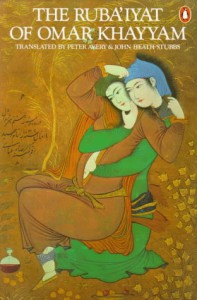 Rami was educated in Paris, “to learn Persian,” he tells us, “for the purpose of translating one single poem, the Rubaiyat of Omar Khayyam, the Quatrains.” Rami was a renowned poet before he became Om Kalthoum’s lyricist; the opening chapters of the novel portray their first meetings. Om urges Rami to write for her after their first encounter, during which she sings in a small theater disguised as a boy, as was typical in her early singing career during the 1920s. Rami describes his alternating sense of unease and wonderment as the “boy” sings one of his poems, written in classical Arabic. The voice creeps into him, filling him “with something so natural it was obscene, unconscious of itself.” A telling detail, if we think about Rabassa’s conundrum: had the “boy” singer not maintained proper distance from the lyric? Rami feels undone as his “words were transformed into what they meant to say; even I believed they were real.” Perhaps the problem here is that Om performed her task all too well.
Rami was educated in Paris, “to learn Persian,” he tells us, “for the purpose of translating one single poem, the Rubaiyat of Omar Khayyam, the Quatrains.” Rami was a renowned poet before he became Om Kalthoum’s lyricist; the opening chapters of the novel portray their first meetings. Om urges Rami to write for her after their first encounter, during which she sings in a small theater disguised as a boy, as was typical in her early singing career during the 1920s. Rami describes his alternating sense of unease and wonderment as the “boy” sings one of his poems, written in classical Arabic. The voice creeps into him, filling him “with something so natural it was obscene, unconscious of itself.” A telling detail, if we think about Rabassa’s conundrum: had the “boy” singer not maintained proper distance from the lyric? Rami feels undone as his “words were transformed into what they meant to say; even I believed they were real.” Perhaps the problem here is that Om performed her task all too well.
So it is that Om, revealed to be a girl through the curve of her breast under rough peasant’s clothing at the end of the concert, is later able to convince Rami to write for her in colloquial Arabic. And so comes a second layer of a translator’s task, to translate in order for a work to reach a wider audience. “How many people understand your words?” Om asks Rami of his lyric poetry. “Why can’t there be poetry in a language which everyone understands, why not?” Granted, this is not translation in the strictest sense of the term. Yet Rami drawn to Om’s demand specifically as a translator, and he is both anxious and excited about her proposition.
Indeed, Rami is sparked to write his first song for Om as he works on his translation of the Rubaiyat, as, he explains, he does every evening. It’s the very nearness and closeness of language, the intimacy and alienation of working with Khayyam’s verses, that lead him to write his first song for Kalthoum:
Arabic and Persian are different, but both are languages of the East, of a same world. The physical proximity plunged me into an exaltation which kept me from sleep. The passage was within reach. And when the meaning was revealed, when the music of the poem found its equivalent in Arabic, I felt the liberation of an emotion that was nine centuries old.
Translation reaches across languages, history, national boundaries and cultural traditions, but it’s even more than that, if we are to heed Rami’s experience. For he realizes, as he grapples with a rough passage of the Rubaiyat, that he is now working on the translation “for her.” He says, “I wanted that girl to sing the Rubaiyat of Omar Khayyam, that was all I wanted. That is what I had to have.” He describes this moment of the zenith of his quest to translate the classic work, as he realizes then that the meaning for which he grasps in the translation will all come together in her voice. In the quiet passage describing Rami’s solitary work, translation becomes musical interpretation becomes an act of sharing, of openness, of vulnerability, of love.
And it is so that he writes his first song for Om, entitled “I’m Afraid that Your Love.” This is a departure from the translation act of writing your ass off within a given story and setting: it is as if Rami describes a translation of the sense and sensibility, a translation of the emotional and visceral power, of Khayyam, to be channeled through Rami’s words and rendered through the voice of the woman who would come to be known as the voice of Egypt.
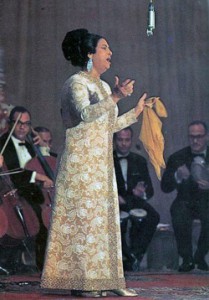
Om Kalthoum, circa 1968
Looking at Anderson’s translation of I Loved You For Your Voice offers this clear insight: the conundrum of translation as treason is responded to through the act of translating itself. Translated works tend to show their seams—in other words, remind the reader that the work is a translation, rather than the original—in the moments when they falter. A successful translation, however, reads seamlessly, and in its seamlessness can offer its own unique response to the peculiar problem of the translator as both reader and writer. As I Loved You for Your Voice progresses from the 1920s through the 1970s, Om Kalthoum singing Rami’s words can be read as a study in translation, the nearness and farness of other languages, cultures, countries, continents. Anderson’s very successful translation of I Loved You for Your Voice resonates within Nassib’s original text. The woven texture in the French of both thematic and literal movements from classical Arabic into colloquial Arabic, from Arabic into French, from lyric poetry into sung verse, remains palpable and present in the English. It is as if Anderson heeded Rami’s description in the text of how he wrote his first song as an invocation of the Rubaiyat for Om, “flowing out word after word, a poem in simple and obvious language…like a letter I might be sending to her.” The latter third of this statement might be the novel’s response to the problem of translation as treason. Alongside the original Oum, I Loved You For Your Voice serves not only as a lesson in translation craft, but also as writerly—and readerly—inspiration.
A particularly satisfying response to Rabassa’s conundrum about what it means to read and write as a translator comes in the process itself. Rabassa is famous for not reading a book before he translates it: he reads as he writes. He alludes to his own returns when he writes, for instance, about “treading very carefully” through a passage of Julio Cortázar’s Hopscotch once Rabassa realized that the passage alternated, sentence by sentence, between the thoughts of a character and lines from a novel he is reading. It might seem that in describing the pause and return, I am describing an obvious part of the writing process: revision. But translation revision is also a process of rereading, since a translator is as bound to reading as she is to writing. Ideally, the revision process will tie her writing more intimately both to her reading and to her reader.
There are all kinds of ways of halting the flow. In my case, graduate seminars and doctoral research served as instructive pauses between the reading and writing of Simha’s work. As I worked on my third and final version of the translation, I condensed into a few months the halting flow of reading and writing then returning with new insight. By the third round, I had learned to pause. Rami poured a Rubaiyat-like sensibility into the early lyrics he composed for Om Kalthoum to sing, but as a translator of Khayyam’s work, he sat hunched over his bed by candlelight each and every night, reading meticulously, writing slowly. Read, write, pause. And return. So grows the seamless skin.
Further links and resources:
- Peruse the full catalog of Europa Editions on their website, europaeditions.com. Approximately two-thirds of the titles on the Europa Editions list are works of literature in translation.
- Read a brief 1988 article from The New York Times, about the award of the Wheatland Prize to translator Gregory Rabassa.
- Watch video of Om Kalthoum singing “Inta Omri.”

